Age and Depositional Temperature of Quaternary Travertine Spring Mounds from Slovakia
Abstract
1. Introduction
2. Geological Settings
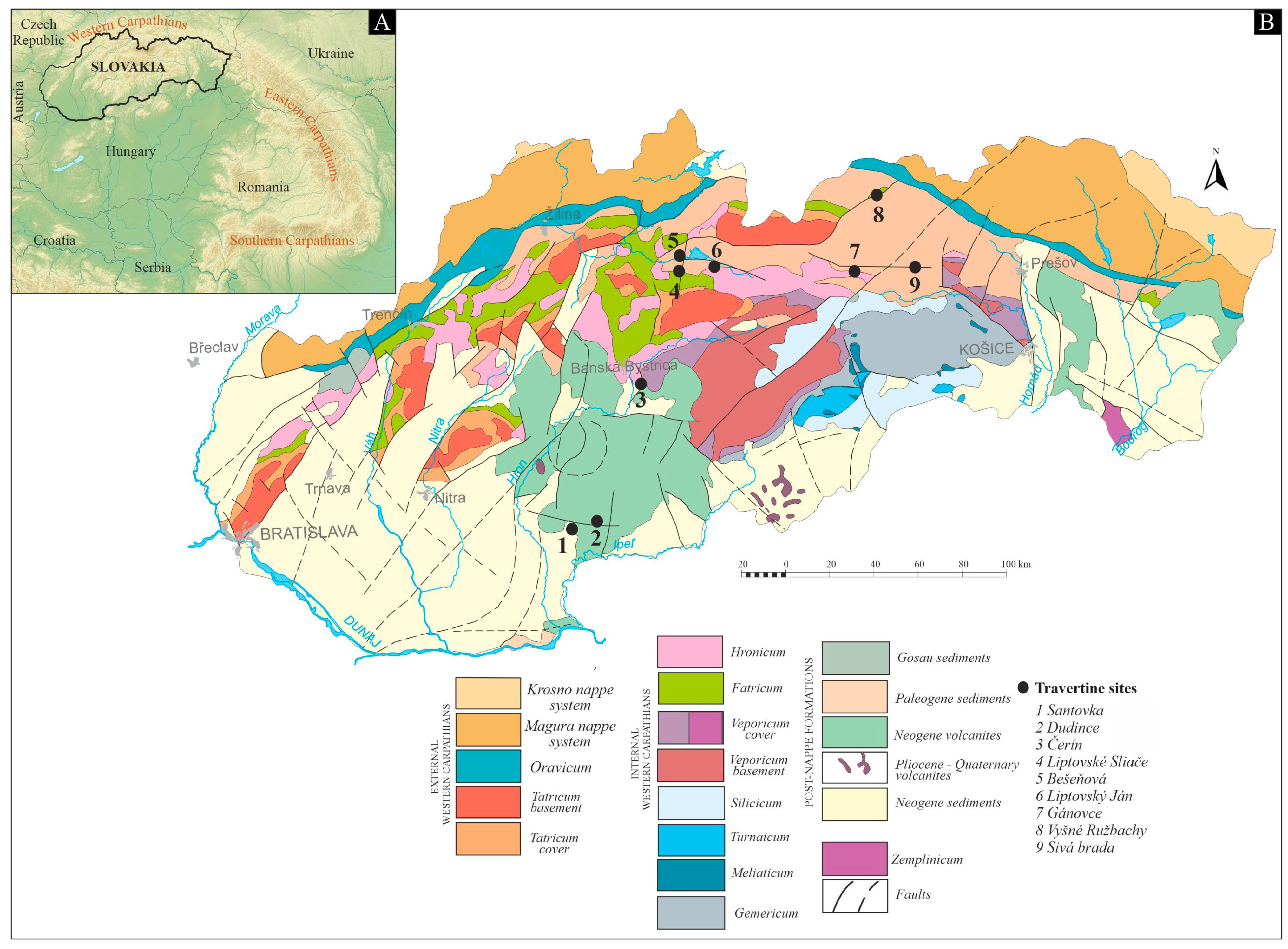
3. Materials and Methods
3.1. Field Studies and Sampling
3.2. δ18O, δ13C, and δ2H Analysis
3.3. Clumped Isotope Analysis
3.4. U-Th Dating
4. Results
4.1. U-Th Geochronological Data
4.2. Isotopic Composition of Carbonates (δ18O, δ13C, and Δ47)
4.3. Isotopic Composition of Water (δ18Ow, δ2H)
5. Discussion
5.1. U-Th Ages
5.2. Travertine Classification and Isotope Signature
5.3. Paleotemperatures
5.4. Isotopic Signature of Paleofluids
6. Conclusions
Supplementary Materials
Author Contributions
Funding
Data Availability Statement
Acknowledgments
Conflicts of Interest
References
- Pivko, D.; Vojtko, R. A review of travertines and tufas in Slovakia: Geomorphology, environments, tectonic pattern, and age distribution. Acta Geol. Slovaca 2021, 13, 49–78. [Google Scholar]
- Pivko, D. A review of Slovak travertine and tufa facies and their environment. Acta Geol. Slovaca 2021, 13, 129–166. [Google Scholar]
- Gradziński, M.; Dulinski, M.; Hercman, H.; Stworzewicz, E.; Holúbek, P.; Rajnoga, P.; Wroblewski, W.; Kováčová, M. Facies and age of travertines from Spiš and Liptov regions (Slovakia)—Preliminary results. Slov. Kras (Acta Carsologica Slovaca) 2008, 46, 31–40. [Google Scholar]
- Gradziński, M.; Wroblewski, W.; Bella, P. Cenozoic freshwater carbonates of the Central Carpathians (Slovakia): Facies, environments, hydrological control and depositional history. In Guidebook Field Trips Accompanying, Proceedings of the 31st IAS Meeting of Sedimentology, Kraków, Poland, 22–25 June 2015; Polish Geological Society: Kraków, Poland, 2015; pp. 217–245. [Google Scholar]
- Gradziński, M.; Wróblewski, W.; Duliński, M.; Hercman, H. Earthquake-affected development of a travertine ridge. Sedimentology 2014, 61, 238–263. [Google Scholar] [CrossRef]
- Kriš, J.; Marton, J.; Skultétyová, I. Mineral and geothermal waters of Slovakia. GeoJournal 1995, 35, 431–442. [Google Scholar] [CrossRef]
- Hyánková, K.; Melioris, L. The unusual chemism of mineral waters at Dudince. Geol. Carpathica 1993, 44, 123–131. [Google Scholar]
- Melioris, L. Mineral and thermal waters of the Ipelská Pahorkatina hillyland. Environ. Geol. 2000, 39, 448–462. [Google Scholar] [CrossRef]
- Šolcová, A.; Petr, L.; Hájková, P.; Petřík, J.; Tóth, P.; Rohovec, J.; Bátora, J.; Horsák, M. Early and middle Holocene ecosystem changes at the Western Carpathian/Pannonian border driven by climate and Neolithic impact. Boreas 2018, 47, 897–909. [Google Scholar] [CrossRef]
- Dabkowski, J.; Frodlová, J.; Hájek, M.; Hájková, P.; Petr, L.; Fiorillo, D.; Dudová, L.; Horsák, M. A complete Holocene climate and environment record for the Western Carpathians (Slovakia) derived from a tufa deposit. Holocene 2019, 29, 493–504. [Google Scholar] [CrossRef]
- Pentecost, A. Geochemistry of carbon dioxide in six travertine-depositing waters of Italy. J. Hydrol. 1995, 167, 263–278. [Google Scholar] [CrossRef]
- Scheuer, G.; Schweitzer, F. A Kárpát-Medence környéki édesvizi mészköelöfordulások összehasonlitésa a hazai adottságokkal, I. Szlovákia. Földtani Közlöny 1981, 111, 453–471. [Google Scholar]
- Chafetz, H.S.; Folk, R.L. Travertines; depositional morphology and the bacterially constructed constituents. J. Sediment. Res. 1984, 54, 289–316. [Google Scholar] [CrossRef]
- Pentecost, A. Travertine; Springer Science & Business Media: Berlin/Heidelberg, Germany, 2005. [Google Scholar]
- Fouke, B.W.; Farmer, J.D.; Des Marais, D.J.; Pratt, L.; Sturchio, N.C.; Burns, P.C.; Discipulo, M.K. Depositional Facies and Aqueous-Solid Geochemistry of Travertine-Depositing Hot Springs (Angel Terrace, Mammoth Hot Springs, Yellowstone National Park, U.S.A.). J. Sediment. Res. 2000, 70, 565–585. [Google Scholar] [CrossRef] [PubMed]
- Andrews, J.E.; Riding, R.; Dennis, P.F. The stable isotope record of environmental and climatic signals in modern terrestrial microbial carbonates from Europe. Palaeogeogr. Palaeoclimatol. Palaeoecol. 1997, 129, 171–189. [Google Scholar] [CrossRef]
- Minissale, A.; Kerrick, D.M.; Magro, G.; Murrell, M.T.; Paladini, M.; Rihs, S.; Sturchio, N.C.; Tassi, F.; Vaselli, O. Geochemistry of Quaternary travertines in the region north of Rome (Italy): Structural, hydrologic and paleoclimatic implications. Earth Planet. Sci. Lett. 2002, 203, 709–728. [Google Scholar] [CrossRef]
- Liu, Z.; Zhang, M.; Li, Q.; You, S. Hydrochemical and isotope characteristics of spring water and travertine in the Baishuitai area (SW China) and their meaning for paleoenvironmental reconstruction. Environ. Geol. 2003, 44, 698–704. [Google Scholar] [CrossRef]
- Kano, A.; Okumura, T.; Shiraishi, F.; Takashima, C. Geomicrobiological Properties and Processes of Travertine: With a Focus on Japanese Sites, 1st ed.; Springer: Singapore, 2019; p. 181. [Google Scholar]
- Brogi, A.; Capezzuoli, E.; Moretti, M.; Olvera-García, E.; Matera, P.F.; Garduno-Monroy, V.-H.; Mancini, A. Earthquake-triggered soft-sediment deformation structures (seismites) in travertine deposits. Tectonophysics 2018, 745, 349–365. [Google Scholar] [CrossRef]
- Bezák, V.; Biely, A.; Elečko, M.; Konečný, V.; Mello, J.; Polák, M.; Potfaj, M. A new synthesis of the geological structure of Slovakia—The general geological map at 1:200,000 scale. Geol. Q. 2011, 55, 1–8. [Google Scholar]
- Hók, J.; Pelech, O.; Teťák, F.; Németh, Z.; Nagy, A. Outline of the geology of Slovakia (W. Carpathians). Miner. Slovaca 2019, 51, 31–60. [Google Scholar]
- Franko, O.; Franko, J. Thermal waters of the Hornonitrianska kotlina depression and their utilization. Environ. Geol. 2000, 39, 501–515. [Google Scholar] [CrossRef]
- Bodiš, D.; Remšík, A.; Černák, R.; Marcin, D.; Ženišová, Z.; Fl’aková, R. Geothermal and hydrogeological conditions, geochemical properties and uses of geothermal waters of the Slovakia. In Geothermal Water Management, 1 ed.; Bundschuh, J., Tomaszewska, B., Eds.; CRC Press: Boca Raton, FL, USA, 2018; pp. 41–62. [Google Scholar]
- Chrobak-Žuffová, A.; Papčo, P. Liptov region and its geotourism wealth. In Proceedings of the GEOTOUR & IRSE 2014, Miskolc, Hungary, 16–18 October 2014; pp. 98–108. [Google Scholar]
- Hók, J.; Kováč, M.; Rakús, M.; Kováč, P.; Nagy, A.; Kováčová-Slamková, M.; Sitár, V.; Šujan, M. Geologic and tectonic evolution of the Turiec depression in the Neogene. Slovak Geol. Mag. 1998, 4, 165–176. [Google Scholar]
- Michalko, J.; Fendek, M. Environmental isotopes in groundwaters of Levočskê Kotlina Basin. In Proceedings of the XVII Congress of Carpathian-Balkan Geological Association, Bratislava, Slovakia, 1–4 September 2002. [Google Scholar]
- Spötl, C.; Vennemann, T.W. Continuous-flow isotope ratio mass spectrometric analysis of carbonate minerals: Letter to the Editor. Rapid Commun. Mass Spectrom. 2003, 17, 1004–1006. [Google Scholar] [CrossRef]
- Epstein, S.; Mayeda, T. Variation of O18 content of waters from natural sources. Geochim. Cosmochim. Acta 1953, 4, 213–224. [Google Scholar] [CrossRef]
- Coplen, T.B.; Wildman, J.D.; Chen, J. Improvements in the gaseous hydrogen-water equilibration technique for hydrogen isotope-ratio analysis. Anal. Chem. 1991, 63, 910–912. [Google Scholar] [CrossRef]
- Bernasconi, S.M.; Hu, B.; Wacker, U.; Fiebig, J.; Breitenbach, S.F.M.; Rutz, T. Background effects on Faraday collectors in gas-source mass spectrometry and implications for clumped isotope measurements: Background effects on Faraday collectors in mass spectrometry. Rapid Commun. Mass Spectrom. 2013, 27, 603–612. [Google Scholar] [CrossRef] [PubMed]
- John, C.M.; Bowen, D. Community software for challenging isotope analysis: First applications of ‘Easotope’ to clumped isotopes: Community software for challenging isotope analysis. Rapid Commun. Mass Spectrom. 2016, 30, 2285–2300. [Google Scholar] [CrossRef] [PubMed]
- Baertschi, P. Absolute18O content of standard mean ocean water. Earth Planet. Sci. Lett. 1976, 31, 341–344. [Google Scholar] [CrossRef]
- IAEA-TECDOC—825; Standards and Intercomparison Materials Distributed by the International Atomic Energy Agency for Stable Isotope Measurements. International Atomic Energy Agency: Vienna, Austria, 1995; pp. 13–29.
- Meijer, H.A.J.; Li, W.J. The Use of Electrolysis for Accurate δ17O and δ18O Isotope Measurements in Water. Isot. Environ. Health Stud. 1998, 34, 349–369. [Google Scholar] [CrossRef]
- Assonov, S.S.; Brenninkmeijer, C.A.M. A redetermination of absolute values for17RVPDB-CO2 and17RVSMOW. Rapid Commun. Mass Spectrom. 2003, 17, 1017–1029. [Google Scholar] [CrossRef] [PubMed]
- Brand, W.A.; Assonov, S.S.; Coplen, T.B. Correction for the 17O interference in δ(13C) measurements when analyzing CO2 with stable isotope mass spectrometry (IUPAC Technical Report). Pure Appl. Chem. 2010, 82, 1719–1733. [Google Scholar] [CrossRef]
- Bernasconi, S.M.; Müller, I.A.; Bergmann, K.D.; Breitenbach, S.F.M.; Fernandez, A.; Hodell, D.A.; Jaggi, M.; Meckler, A.N.; Millan, I.; Ziegler, M. Reducing Uncertainties in Carbonate Clumped Isotope Analysis Through Consistent Carbonate-Based Standardization. Geochem. Geophys. Geosystems 2018, 19, 2895–2914. [Google Scholar] [CrossRef] [PubMed]
- Daëron, M.; Blamart, D.; Peral, M.; Affek, H.P. Absolute isotopic abundance ratios and the accuracy of Δ47 measurements. Chem. Geol. 2016, 442, 83–96. [Google Scholar] [CrossRef]
- Schauer, A.J.; Kelson, J.; Saenger, C.; Huntington, K.W. Choice of 17O correction affects clumped isotope (Δ47) values of CO2 measured with mass spectrometry: 17O correction affects CO2 clumped isotopes. Rapid Commun. Mass Spectrom. 2016, 30, 2607–2616. [Google Scholar] [CrossRef] [PubMed]
- Bernasconi, S.; Daëron, M.; Bergmann, K.D.; Bonifacie, M.; Meckler, A.N. InterCarb: A community effort to improve inter-laboratory standardization of the carbonate clumped isotope thermometer using carbonate standards. Geochemistry 2020, 22, e2020GC009588. [Google Scholar]
- Anderson, N.T.; Kelson, J.R.; Kele, S.; Daëron, M.; Bonifacie, M.; Horita, J.; Mackey, T.J.; John, C.M.; Kluge, T.; Petschnig, P.; et al. A Unified Clumped Isotope Thermometer Calibration (0.5–1100 °C) Using Carbonate-Based Standardization. Geophys. Res. Lett. 2021, 48, e2020GL092069. [Google Scholar] [CrossRef]
- Shen, C.-C.; Lawrence Edwards, R.; Cheng, H.; Dorale, J.A.; Thomas, R.B.; Bradley Moran, S.; Weinstein, S.E.; Edmonds, H.N. Uranium and thorium isotopic and concentration measurements by magnetic sector inductively coupled plasma mass spectrometry. Chem. Geol. 2002, 185, 165–178. [Google Scholar] [CrossRef]
- Shen, C.-C.; Wu, C.-C.; Cheng, H.; Lawrence Edwards, R.; Hsieh, Y.-T.; Gallet, S.; Chang, C.-C.; Li, T.-Y.; Lam, D.D.; Kano, A.; et al. High-precision and high-resolution carbonate 230Th dating by MC-ICP-MS with SEM protocols. Geochim. Cosmochim. Acta 2012, 99, 71–86. [Google Scholar] [CrossRef]
- Cheng, H.; Lawrence Edwards, R.; Shen, C.-C.; Polyak, V.J.; Asmerom, Y.; Woodhead, J.; Hellstrom, J.; Wang, Y.; Kong, X.; Spötl, C.; et al. Improvements in 230Th dating, 230Th and 234U half-life values, and U–Th isotopic measurements by multi-collector inductively coupled plasma mass spectrometry. Earth Planet. Sci. Lett. 2013, 371–372, 82–91. [Google Scholar] [CrossRef]
- Kele, S.; Breitenbach, S.F.M.; Capezzuoli, E.; Meckler, A.N.; Ziegler, M.; Millan, I.M.; Kluge, T.; Deák, J.; Hanselmann, K.; John, C.M.; et al. Temperature dependence of oxygen- and clumped isotope fractionation in carbonates: A study of travertines and tufas in the 6–95 °C temperature range. Geochim. Cosmochim. Acta 2015, 168, 172–192. [Google Scholar] [CrossRef]
- Panichi, C.; Tongiorgi, E. Carbon isotopic composition of CO2 from springs, fumaroles, mofettes and travertines of central and southern Italy: A preliminary prospection method of geothermal areas. In Proceedings of the 2nd United Nations Symposium on the Development and Use of Geothermal Resources, San Francisco, CA, USA, 20 May 1975. [Google Scholar]
- Bačová, N.; Nemeth, Z.; Repčiak, M. Mineral Waters of the Dudince Spa. Slovak Geol. Mag. 2016, 16, 125–147. [Google Scholar]
- Holko, L.; Dóša, M.; Michalko, J.; Šanda, M. Isotopes of oxygen-18 and deuterium in precipitation in Slovakia/Izotopy kyslíka-18 A deutéria v zrážkach na Slovensku. J. Hydrol. Hydromech. 2012, 60, 265–276. [Google Scholar] [CrossRef]
- Craig, H. Standard for reporting concentrations of deuterium and oxygen-18 in natural waters. Science 1961, 133, 1833–1834. [Google Scholar] [CrossRef]
- Petrbok, J. Mekkýši travertinù slovenského Krasu, Gánovcù s okolím, Spiše a Ružbachù. Rozpr. II. Tøídy Èeské Akad. 1937, 46, 1–16. [Google Scholar]
- Ložek, V.; Prošek, F. Krasové zjevy v travertinech a jejich statigrafický význam. Československý Kras 1957, 10, 145–158. [Google Scholar]
- Del Tredici, P. Ginkgos and multituberculates: Evolutionary interactions in the Tertiary. Biosystems 1989, 22, 327–339. [Google Scholar] [CrossRef] [PubMed]
- Ložek, V. Nové interglaciální malakofauny ze Slovenska. (Neue interglaziale Molluskenfaunen in der Slowakei). Anthropozoikum 1958, 7, 37–45. [Google Scholar]
- Holec, P. Teeth casts of Mastodont species Mammut borsoni (Hays, 1834) from the Dreveník travertine near Spišské Podhradie. Miner. Slovaca 1992, 24, 467–469. [Google Scholar]
- Fordinál, K.; Nagy, A. Hlavina member—Marginal Upper Pannonian sediments of the Rišňovce depression. Miner. Slovaca 1997, 29, 401–406. [Google Scholar]
- Kaminská, L. Príspevok k poznaniu micoquienu na Slovensku. In Ecce Homo, in Memoriam Jan Fridrich; Krigl Jan: Praha, Czech Republic, 2010; pp. 90–94. ISBN 9788086912455. [Google Scholar]
- Tóth, C.; Krempaská, Z. Pliocene Proboscidea remains from travertine Dreveník site (near Spišské Podhradie, Slovakia). In Proceedings of the 6th Meeting of The European Association of Vertebrate Palaeontologists, Spišská Nová Ves, Slovakia, 30 June–5 July 2008; p. 116. [Google Scholar]
- Nemergut, A. Sídlisková Geografia Považia a Ponitria v Staršej Dobe Kamennej. Ph.D. Thesis, Masarykova Univerzita v Brně, Brno, Czech Republic, 2011. [Google Scholar]
- Wróblewski, W.; Gradziński, M.; Hercman, H. Suggestions on the allochthonous origin of terra rossa from Drevenik Hill (Spiš, Slovakia). Slov. Kras 2010, 48, 153–161. [Google Scholar]
- Kovanda, J.; Smolíkovà, L.; Ford, D.; Kaminská, L.; Ložek, V.; Horácek, I. The Skalka travertine mound at Hôrce-Ondrej near Poprad (Slovakia). Sborník Geol. Ved–Antropozoikum 1995, 22, 113–140. [Google Scholar]
- Frank, N.; Braum, M.; Hambach, U.; Mangini, A.; Wagner, G. Warm Period Growth of Travertine during the Last Interglaciation in Southern Germany. Quat. Res. 2000, 54, 38–48. [Google Scholar] [CrossRef]
- Rihs, S.; Condomines, M.; Poidevin, J.-L. Long-term behaviour of continental hydrothermal systems. Geochim. Cosmochim. Acta 2000, 64, 3189–3199. [Google Scholar] [CrossRef]
- Soligo, M.; Tuccimei, P.; Barberi, R.; Delitala, M.C.; Miccadei, E.; Taddeucci, A. U/Th dating of freshwater travertine from Middle Velino Valley (Central Italy): Paleoclimatic and geological implications. Palaeogeogr. Palaeoclimatol. Palaeoecol. 2002, 184, 147–161. [Google Scholar] [CrossRef]
- Lisiecki, L.E.; Raymo, M.E. A Pliocene-Pleistocene stack of 57 globally distributed benthic δ18O records. Paleoceanography 2005, 20, 9–11. [Google Scholar] [CrossRef]
- Gradziński, M.; Hercman, H.; Jaśkiewicz, M.; Szczurek, S. Holocene tufa in the Slovak Karst: Facies, sedimentary environments and depositional history. Geol. Q. 2013, 57, 769–788. [Google Scholar] [CrossRef]
- Clark, P.U.; Dyke, A.S.; Shakun, J.D.; Carlson, A.E.; Clark, J.; Wohlfarth, B.; Mitrovica, J.X.; Hostetler, S.W.; McCabe, A.M. The last glacial maximum. Science 2009, 325, 710–714. [Google Scholar] [CrossRef]
- Bertini, A.; Minissale, A.; Ricci, M. Use of Quaternary travertines of central-southern Italy as archives of paleoclimate, paleohydrology and neotectonics. Alp. Mediterr. Quat. 2008, 21, 99–112. [Google Scholar]
- Ricketts, J.W.; Ma, L.; Wagler, A.E.; Garcia, V.H. Global travertine deposition modulated by oscillations in climate. J. Quat. Sci. 2019, 34, 558–568. [Google Scholar] [CrossRef]
- Uysal, I.T.; Feng, Y.-X.; Zhao, J.-X.; Isik, V.; Nuriel, P.; Golding, S.D. Hydrothermal CO2 degassing in seismically active zones during the late Quaternary. Chem. Geol. 2009, 265, 442–454. [Google Scholar] [CrossRef]
- Pentecost, A.; Viles, H. A review and reassessment of travertine classification. Géogr. Phys. Quat. 1994, 48, 305–314. [Google Scholar] [CrossRef]
- Gandin, A.; Capezzuoli, E. Travertine versus calcareous tufa: Distinctive petrologic features and stable isotopes signatures. Alp. Mediterr. Quat. 2008, 21, 125–136. [Google Scholar]
- Berardi, G.; Vignaroli, G.; Billi, A.; Rossetti, F.; Soligo, M.; Kele, S.; Baykara, M.O.; Bernasconi, S.M.; Castorina, F.; Tecce, F.; et al. Growth of a Pleistocene giant carbonate vein and nearby thermogene travertine deposits at Semproniano, southern Tuscany, Italy: Estimate of CO2 leakage. Tectonophysics 2016, 690, 219–239. [Google Scholar] [CrossRef]
- Della Porta, G.; Hoppert, M.; Hallmann, C.; Schneider, D.; Reitner, J. The influence of microbial mats on travertine precipitation in active hydrothermal systems (Central Italy). Depos. Rec. 2022, 8, 165–209. [Google Scholar] [CrossRef]
- Kele, S.; Özkul, M.; Fórizs, I.; Gökgöz, A.; Baykara, M.O.; Alçiçek, M.C.; Németh, T. Stable isotope geochemical study of Pamukkale travertines: New evidences of low-temperature non-equilibrium calcite-water fractionation. Sediment. Geol. 2011, 238, 191–212. [Google Scholar] [CrossRef]
- Özkul, M.; Kele, S.; Gökgöz, A.; Shen, C.-C.; Jones, B.; Baykara, M.O.; Fόrizs, I.; Németh, T.; Chang, Y.-W.; Alçiçek, M.C. Comparison of the Quaternary travertine sites in the Denizli extensional basin based on their depositional and geochemical data. Sediment. Geol. 2013, 294, 179–204. [Google Scholar] [CrossRef]
- Kele, S.; Vaselli, O.; Szabó, C.; Minissale, A. Stable isotope geochemistry of Pleistocene travertine from Budakalász (Buda Mts, Hungary). Acta Geol. Hung. 2003, 46, 161–175. [Google Scholar] [CrossRef]
- Hoefs, J. Stable Isotope Geochemistry; Springer: Berlin/Heidelberg, Germany, 1997. [Google Scholar]
- Cornides, I.; Kecskés, Á. Deep-seated carbon dioxide in Slovakia: The problem of its origin. Geol. Carpathica 1982, 33, 183–190. [Google Scholar]
- Cornides, I.; Kecskes, A. Deep-seated carbon dioxide in Slovakia: Additional comments on the problem of its origin. Geol. Zb. 1987, 38, 429–435. [Google Scholar]
- Cornides, I.; Takaoka, N.; Nagao, K.; Matsuo, S. Contribution of mantle-derived gases to subsurface gases in a tectonically quiescent area, the Carpathian Basin, Hungary revealed by noble gas measurements. Geochem. J. 1986, 20, 119–125. [Google Scholar] [CrossRef]
- Clark, I.D.; Fritz, P. Environmental Isotopes in Hydrogeology; CRC Press/Lewis Publishers: Boca Raton, FL, USA, 1997. [Google Scholar]
- Trček, B.; Albrecht, L. Overview of isotopic investigations of groundwaters in a fractured aquifer system near Rogaška Slatina, Slovenia. Geologija 2017, 60, 49–60. [Google Scholar] [CrossRef]
- Franko, O.; Šivo, A.; Richtáriková, M.; Povinec, P.P. Radiocarbon Ages of Mineral and Thermal Waters of Slovakia. Acta Phys. Univ. Comen. 2008, 49, 111–124. [Google Scholar]
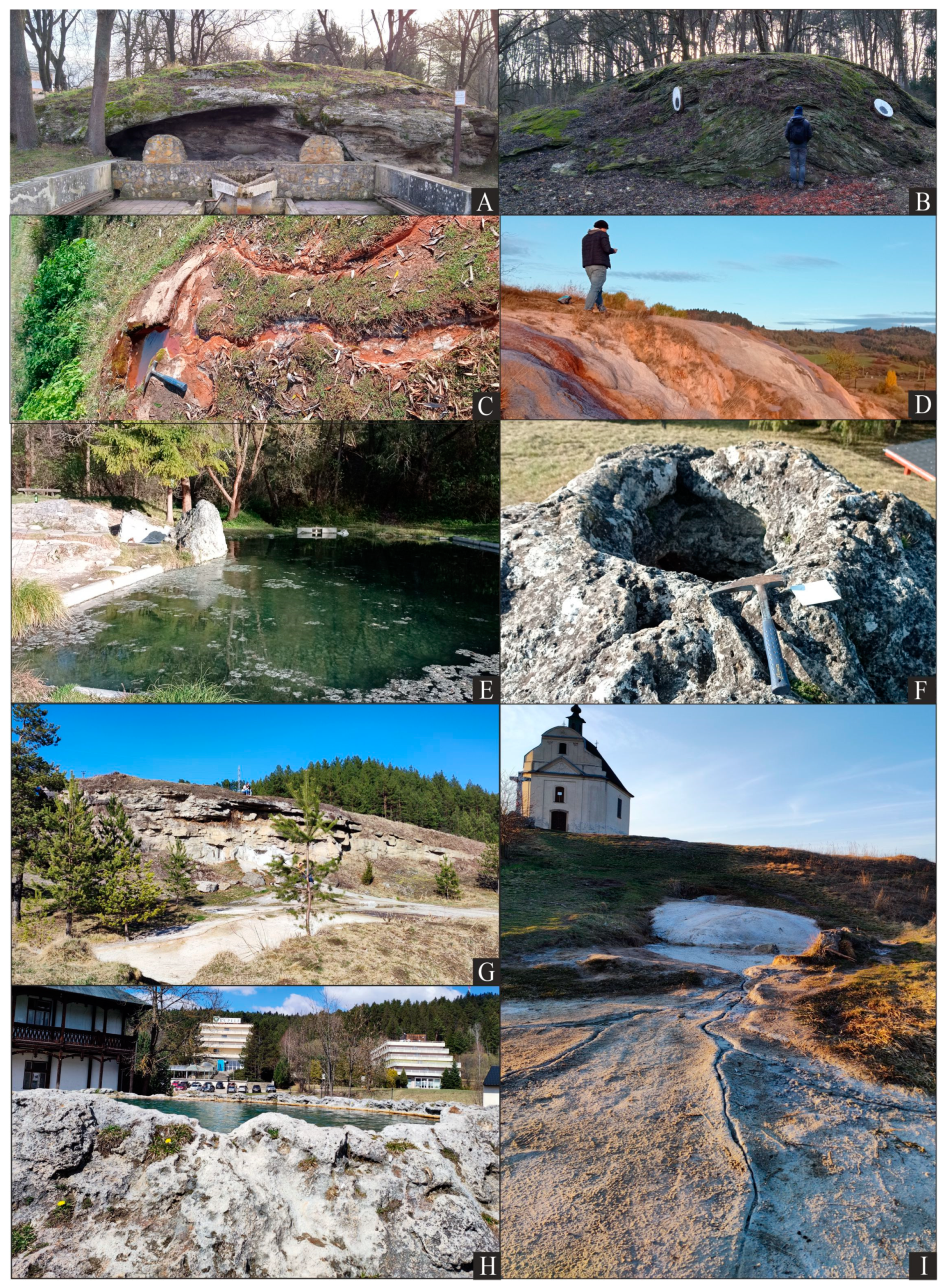
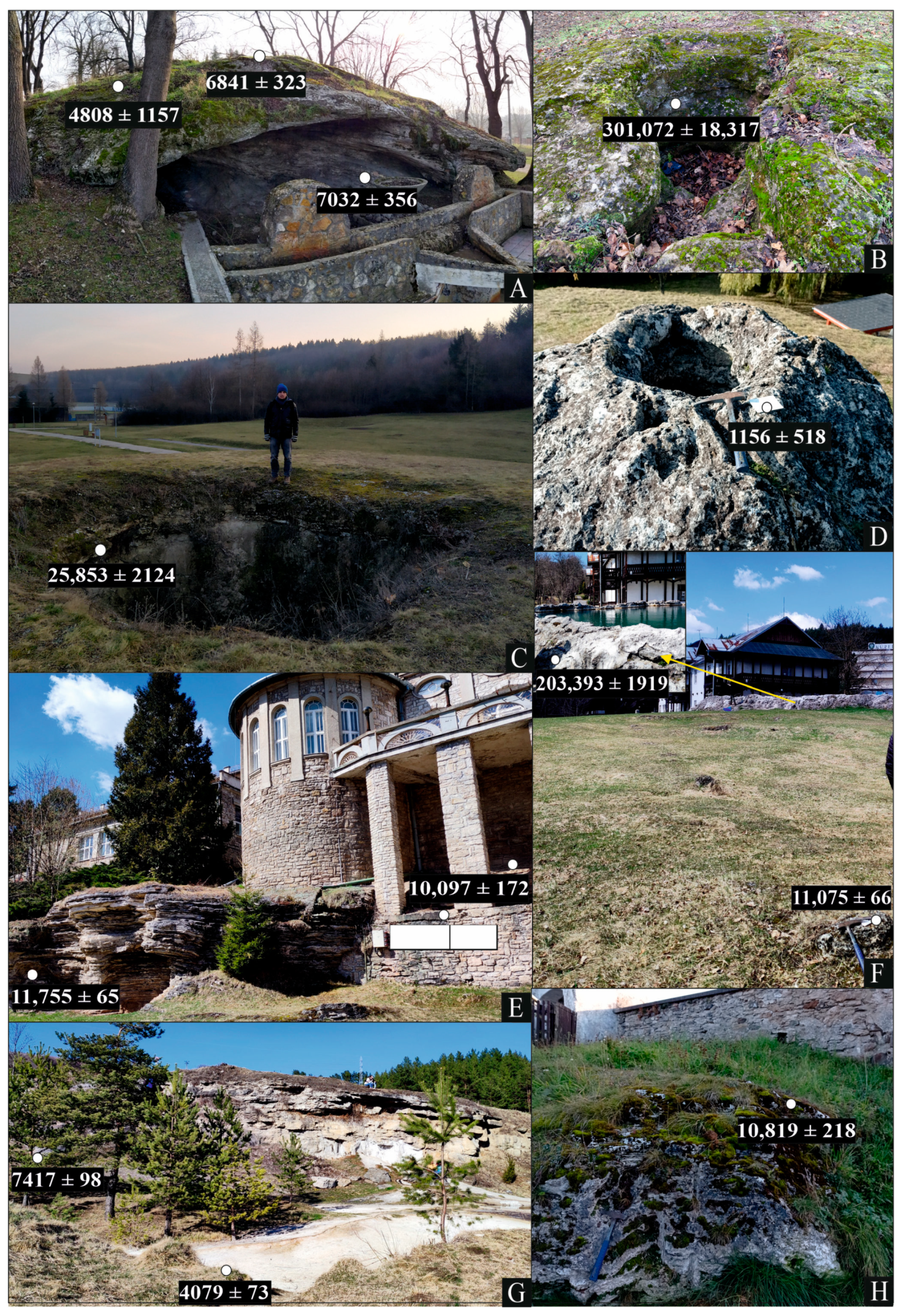
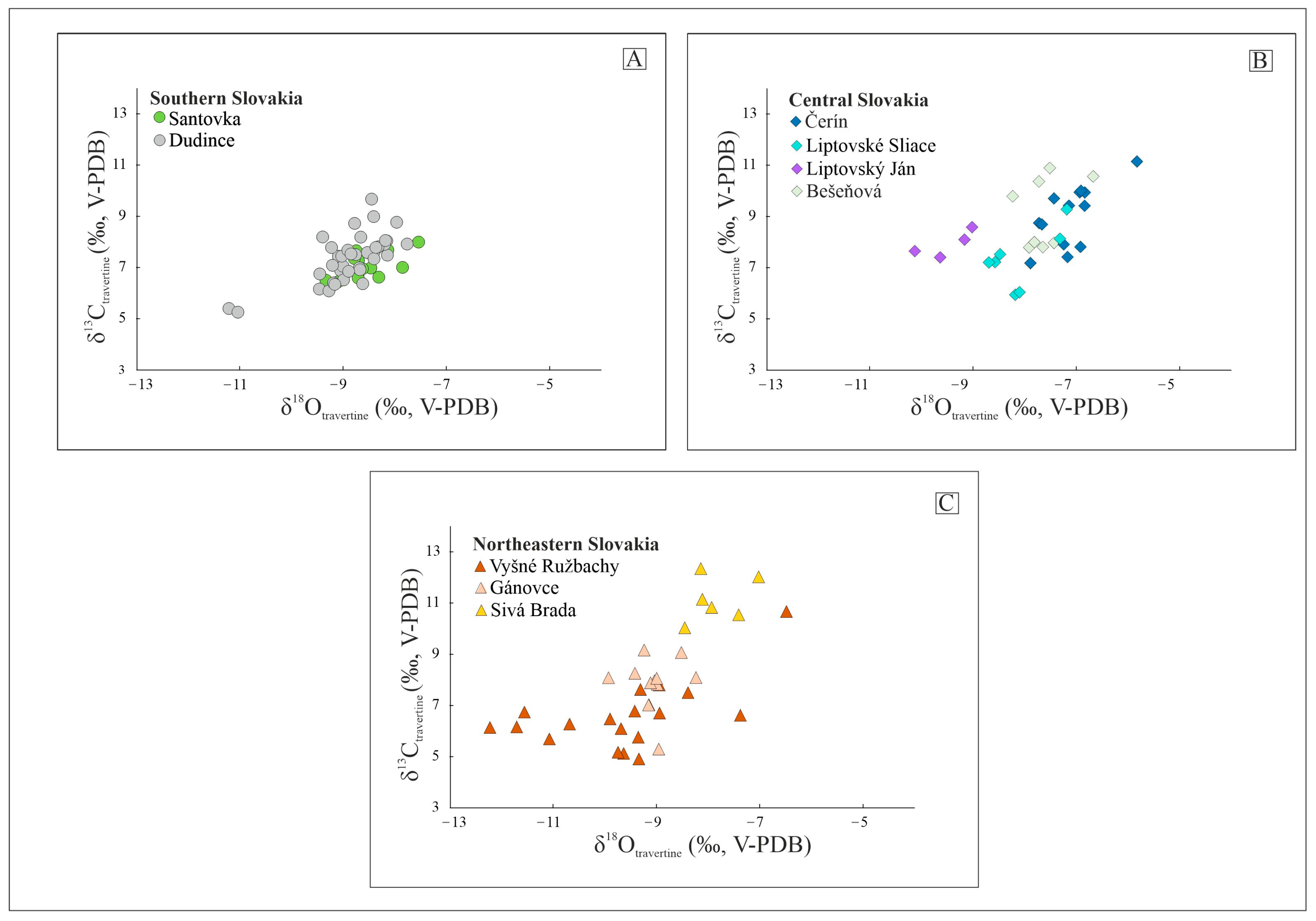
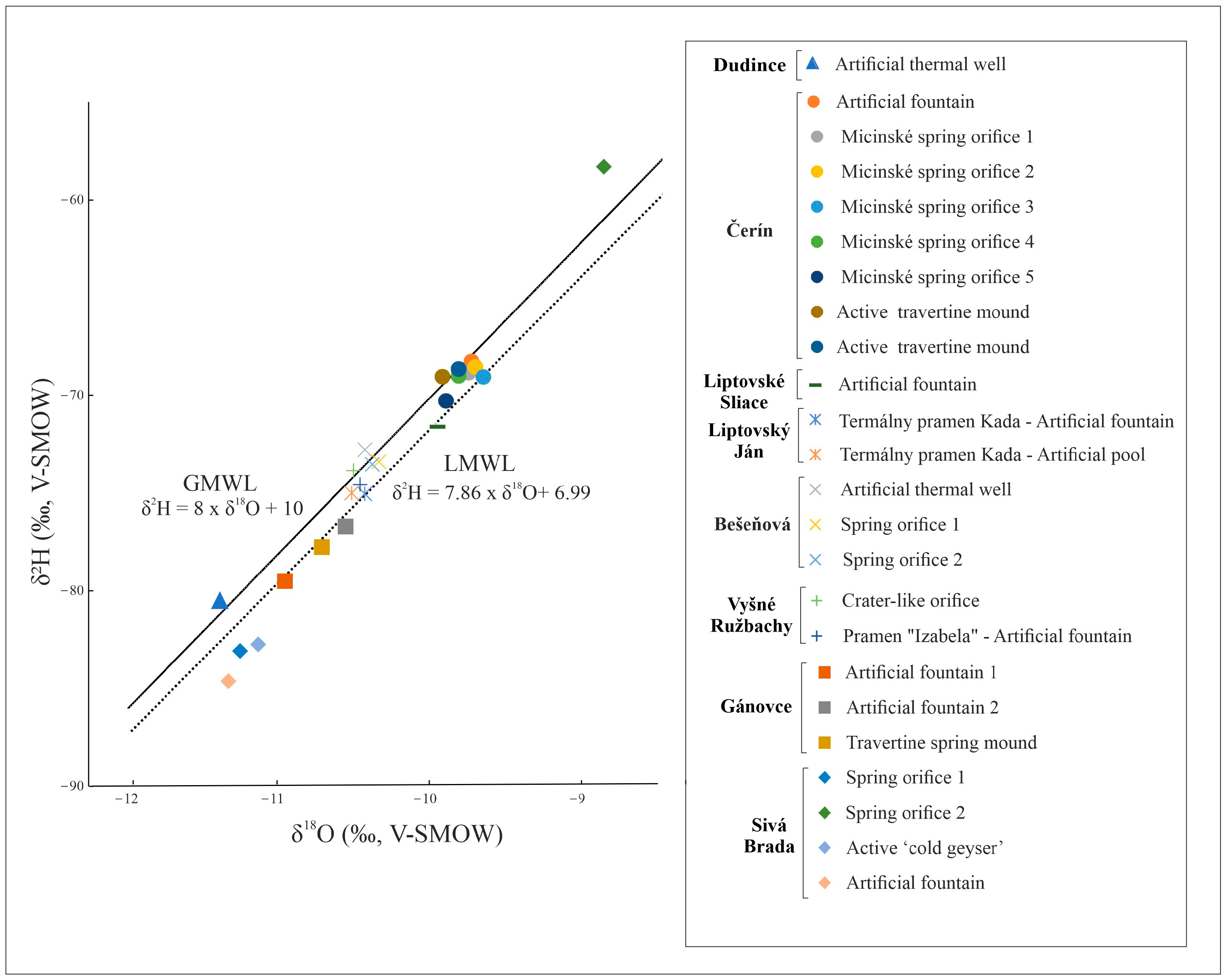
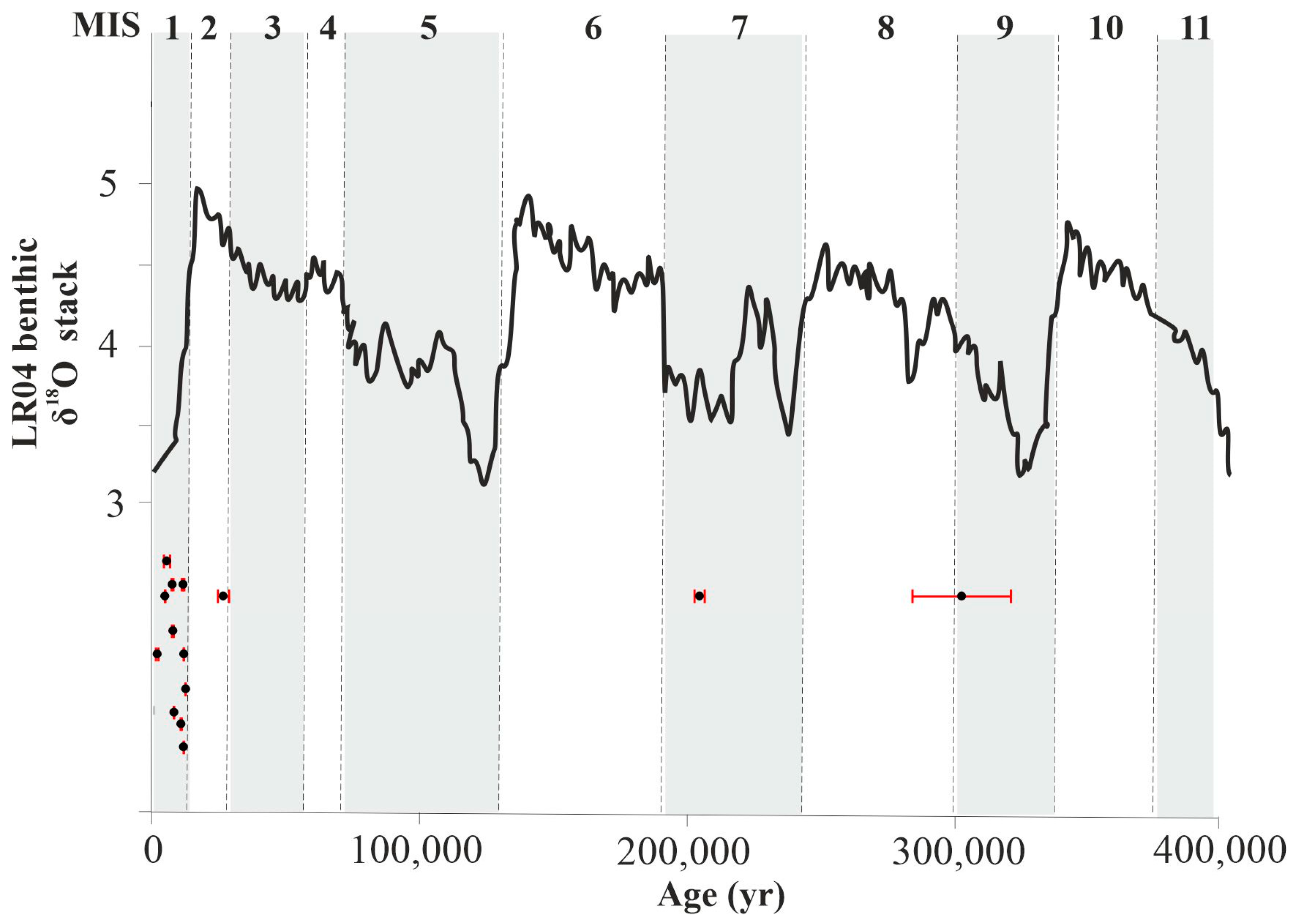
| Locality | 238U (ppb) | 232Th (ppt) | δ234U a | [230Th/238U] Activity c | 230Th/232Th (ppm) | Age (yr Ago) Uncorrected | Age (yr Ago) Corrected c,d | Age (yr BP) * | δ234Uinitial Corrected b |
|---|---|---|---|---|---|---|---|---|---|
| Santovka | 71 | 3814 ± 8 | 1286 ± 5 | 0.1534 ± 0.0018 | 47 ± 1 | 7530 ± 91 | 6912 ± 323 | 6841 ± 323 | 1311 ± 5 |
| 396 | 32,618 ± 3 | 471 ± 3 | 0.0856 ± 0.0005 | 19 ± 0 | 6515 ± 39 | 4880 ± 1157 | 4808 ± 1157 | 478 ± 4 | |
| 63 | 3190 ± 7 | 1027 ± 21 | 0.1400 ± 0.0020 | 46 ± 1 | 7759 ± 141 | 7104 ± 356 | 7032 ± 356 | 1048 ± 21 | |
| Dudince | 139 | 52,503 ± 14 | 2518 ± 8 | 0.8431 ± 0.0017 | 37 ± 0 | 28,917 ± 95 | 25,925 ± 2124 | 25,853 ± 2124 | 2710 ± 18 |
| 97 | 1335 ± 24 | 1213 ± 3 | 2.4304 ± 0.0403 | 2900 ± 71 | 301,239 ± 18,330 | 301,144 ± 18,317 | 301,072 ± 18,317 | 2838 ± 161 | |
| Lip. Sliače | 370 | 15,187 ± 1 | 638 ± 4 | 0.0292 ± 0.0005 | 15 ± 0 | 1958 ± 35 | 1228 ± 518 | 1156 ± 518 | 640 ± 4 |
| Lip. Ján | 239 | 3686 ± 1 | 493 ± 3 | 0.1463 ± 0.0006 | 155 ± 1 | 11,188 ± 58 | 10,891 ± 218 | 10,819 ± 218 | 508 ± 4 |
| Vyšné Ružbachy | 789 | 20,995 ± 1 | 79 ± 2 | 0.9287 ± 0.0017 | 557 ± 1 | 204,146 ± 1871 | 203,465 ± 1919 | 203,393 ± 1919 | 140 ± 4 |
| 806 | 835 ± 0 | 96 ± 2 | 0.1069 ± 0.0005 | 864 ± 13 | 11,174 ± 63 | 11,147 ± 66 | 11,075 ± 66 | 100 ± 3 | |
| 1320 | 130 ± 0 | 90 ± 2 | 0.1122 ± 0.0005 | 1806 ± 780 | 11,825 ± 65 | 11,827 ± 65 | 11,755 ± 65 | 93 ± 2 | |
| 978 | 8026 ± 2 | 106 ± 3 | 0.1006 ± 0.0007 | 193 ± 2 | 10,385 ± 80 | 10,169 ± 172 | 10,097 ± 172 | 109 ± 3 | |
| 1173 | 650 ± 0 | 89 ± 2 | 0.1060 ± 0.0005 | 1153 ± 26 | 11,149 ± 63 | 11,134 ± 64 | 11,062 ± 64 | 92 ± 2 | |
| Gánovce | 163 | 1007 ± 0 | 448 ± 3 | 0.0979 ± 0.0005 | 240 ± 1 | 7612 ± 46 | 7489 ± 98 | 7417 ± 98 | 457 ± 3 |
| 261 | 1207 ± 0 | 459 ± 3 | 0.0558 ± 0.0004 | 186 ± 2 | 4243 ± 34 | 4151 ± 73 | 4079 ± 73 | 465 ± 3 |
| Locality | ID | Lithofacies | δ13C (V-PDB) ‰ | δ18O (V-PDB) ‰ | Δ47 (I-CDES90) (‰) | Δ47 (I-CDES90) std Error (‰) | T∆47 (°C) | ± | δ18Ow | δ13CCO2 | T °C |
|---|---|---|---|---|---|---|---|---|---|---|---|
| 1 | STV5 | Vent | 6.4 | −9.0 | 0.571 | 0.0111 | 32 | 4 | −8.1 | −2.9 | 11.2–26 * |
| STV38 | Distal Slope | 7.2 | −8.6 | 0.638 | 0.0089 | 10 | 3 | −12.7 | −1.9 | ||
| 2 | DUD1 | Vent | 7.7 | −8.2 | 0.608 | 0.0148 | 20 | 5 | −10.0 | −1.3 | 10.7–30 * |
| DUD2 | Vent | 7.8 | −8.0 | 0.604 | 0.0089 | 21 | 3 | −9.6 | −1.1 | ||
| DUD6 | Proximal Slope | 7.9 | −8.2 | 0.601 | 0.0148 | 22 | 5 | −9.5 | −1.0 | ||
| DUD15 | Distal Slope | 8.0 | −8.1 | 0.614 | 0.0070 | 18 | 2 | −10.3 | −0.9 | ||
| DUD18 | Vent | 8.0 | −8.4 | 0.588 | 0.0120 | 26 | 4 | −8.8 | −0.9 | ||
| DUD23 | Vent | 7.6 | −8.9 | 0.631 | 0.0103 | 12 | 3 | −12.5 | −1.4 | ||
| DUD29 | Parasite Vent | 8.3 | −8.8 | 0.582 | 0.0100 | 28 | 4 | −8.7 | −0.6 | ||
| 3 | C7 | Vent | 7.5 | −7.3 | 0.660 | 0.0104 | 4 | 3 | −13.0 | −1.5 | 7.9–13.3 |
| 4 | S14 | Vent | 6.5 | −7.8 | 0.655 | 0.0140 | 6 | 4 | −13.0 | −2.8 | 17.4 |
| S19 | Distal Slope | 7.5 | −8.6 | 0.613 | 0.0136 | 18 | 4 | −10.8 | −1.5 | ||
| 5 | L24 | Distal Slope | 8.4 | −9.1 | 0.650 | 0.0124 | 7 | 3 | −13.9 | −0.5 | 18.7–24.5 |
| 6 | B32 | Proximal Slope | 7.2 | −7.3 | 0.652 | 0.0070 | 6 | 2 | −12.4 | −1.8 | 14–15.6 |
| B34 | Distal Slope | 7.8 | −8.0 | 0.632 | 0.0063 | 12 | 2 | −11.6 | −1.2 | ||
| 7 | N12 | Distal Slope | 6.5 | −10.1 | 0.604 | 0.0099 | 21 | 3 | −11.6 | −2.7 | 20.7–22.2 |
| N13 | Proximal Slope | 6.2 | −12.1 | 0.609 | 0.0115 | 19 | 4 | −14.0 | −3.0 | ||
| 8 | N27 | Distal Slope | 8.0 | −8.9 | 0.615 | 0.0104 | 17 | 3 | −11.4 | −0.9 | 22.4–23.8 |
| N29 | Distal Slope | 9.2 | −9.3 | 0.618 | 0.0108 | 17 | 3 | −11.7 | 0.5 | ||
| 9 | N32 | Vent | 10.1 | −8.5 | 0.608 | 0.0162 | 20 | 5 | −10.2 | 1.7 | 5.5–13.6 |
Disclaimer/Publisher’s Note: The statements, opinions and data contained in all publications are solely those of the individual author(s) and contributor(s) and not of MDPI and/or the editor(s). MDPI and/or the editor(s) disclaim responsibility for any injury to people or property resulting from any ideas, methods, instructions or products referred to in the content. |
© 2023 by the authors. Licensee MDPI, Basel, Switzerland. This article is an open access article distributed under the terms and conditions of the Creative Commons Attribution (CC BY) license (https://creativecommons.org/licenses/by/4.0/).
Share and Cite
Vieira, D.S.C.; Pivko, D.; Rinyu, L.; Palcsu, L.; Kiss, G.I.; Hu, H.-M.; Shen, C.-C.; Kele, S. Age and Depositional Temperature of Quaternary Travertine Spring Mounds from Slovakia. Minerals 2023, 13, 794. https://doi.org/10.3390/min13060794
Vieira DSC, Pivko D, Rinyu L, Palcsu L, Kiss GI, Hu H-M, Shen C-C, Kele S. Age and Depositional Temperature of Quaternary Travertine Spring Mounds from Slovakia. Minerals. 2023; 13(6):794. https://doi.org/10.3390/min13060794
Chicago/Turabian StyleVieira, Daniella S. C., Daniel Pivko, László Rinyu, László Palcsu, Gabriella I. Kiss, Hsun-Ming Hu, Chuan-Chou Shen, and Sándor Kele. 2023. "Age and Depositional Temperature of Quaternary Travertine Spring Mounds from Slovakia" Minerals 13, no. 6: 794. https://doi.org/10.3390/min13060794
APA StyleVieira, D. S. C., Pivko, D., Rinyu, L., Palcsu, L., Kiss, G. I., Hu, H.-M., Shen, C.-C., & Kele, S. (2023). Age and Depositional Temperature of Quaternary Travertine Spring Mounds from Slovakia. Minerals, 13(6), 794. https://doi.org/10.3390/min13060794







